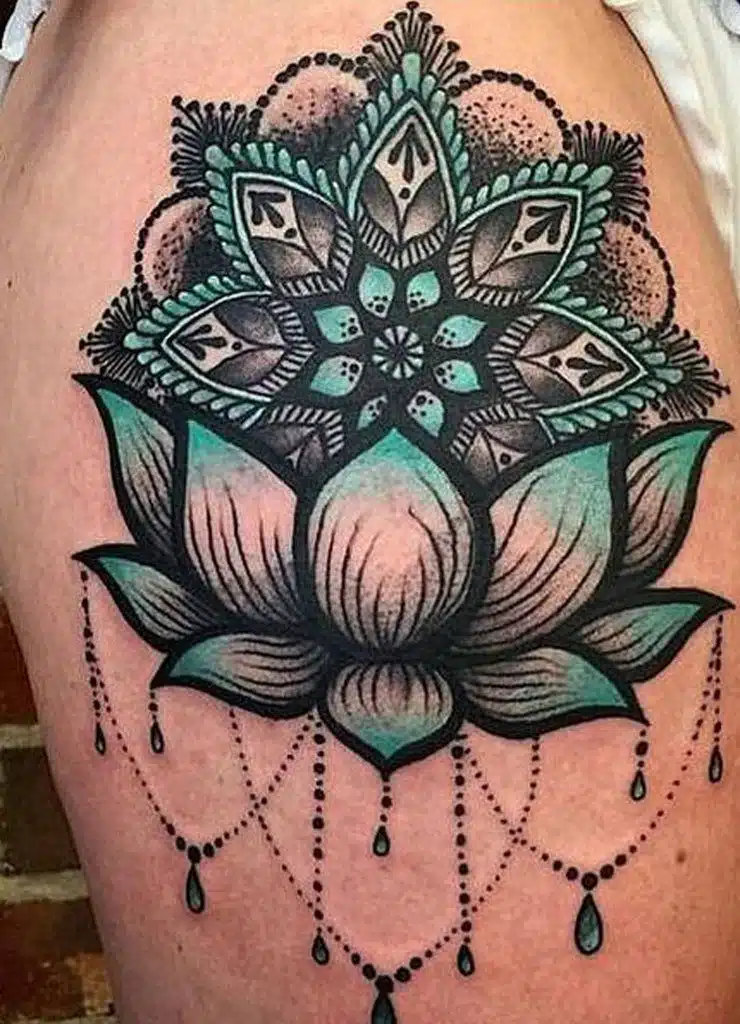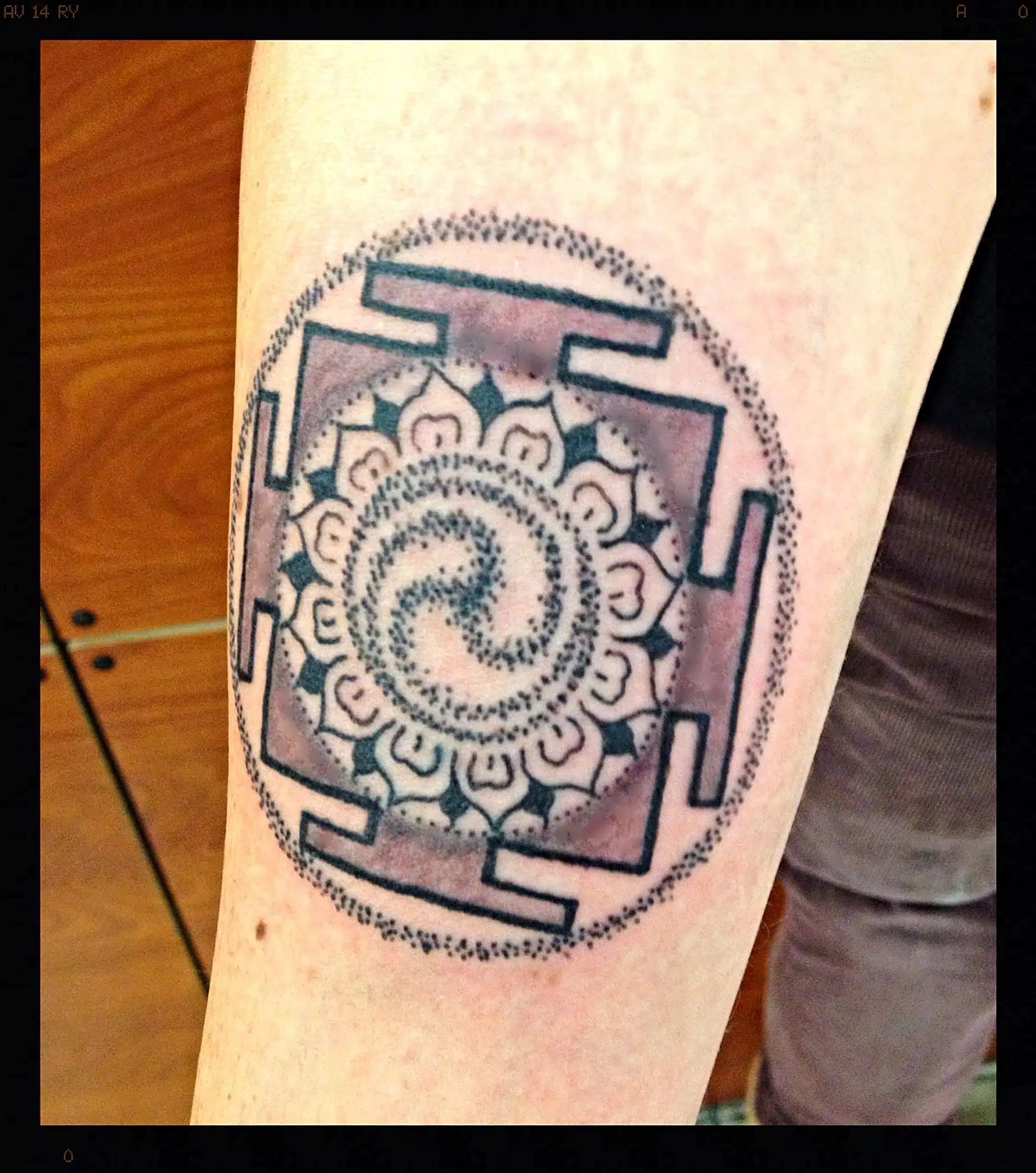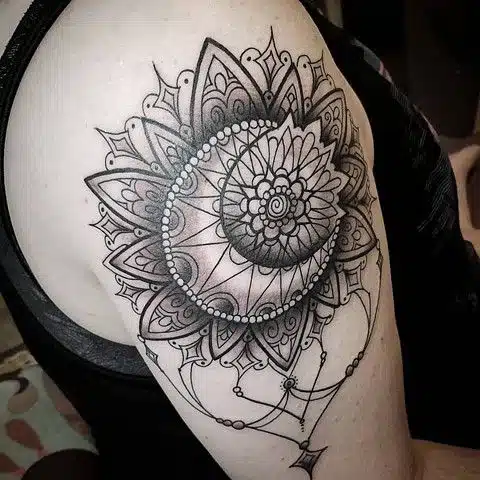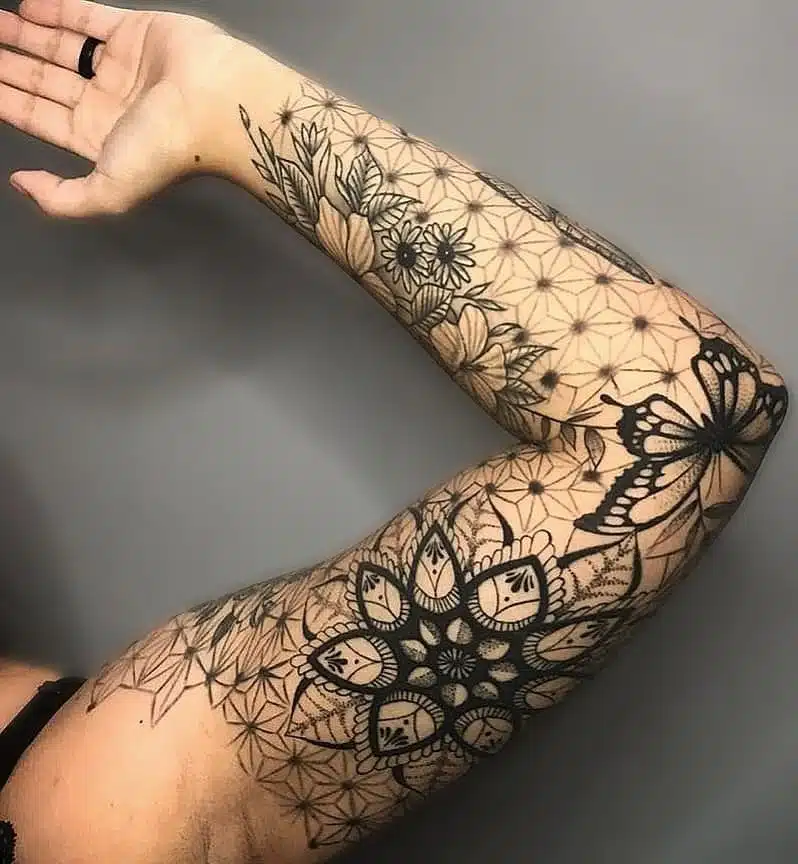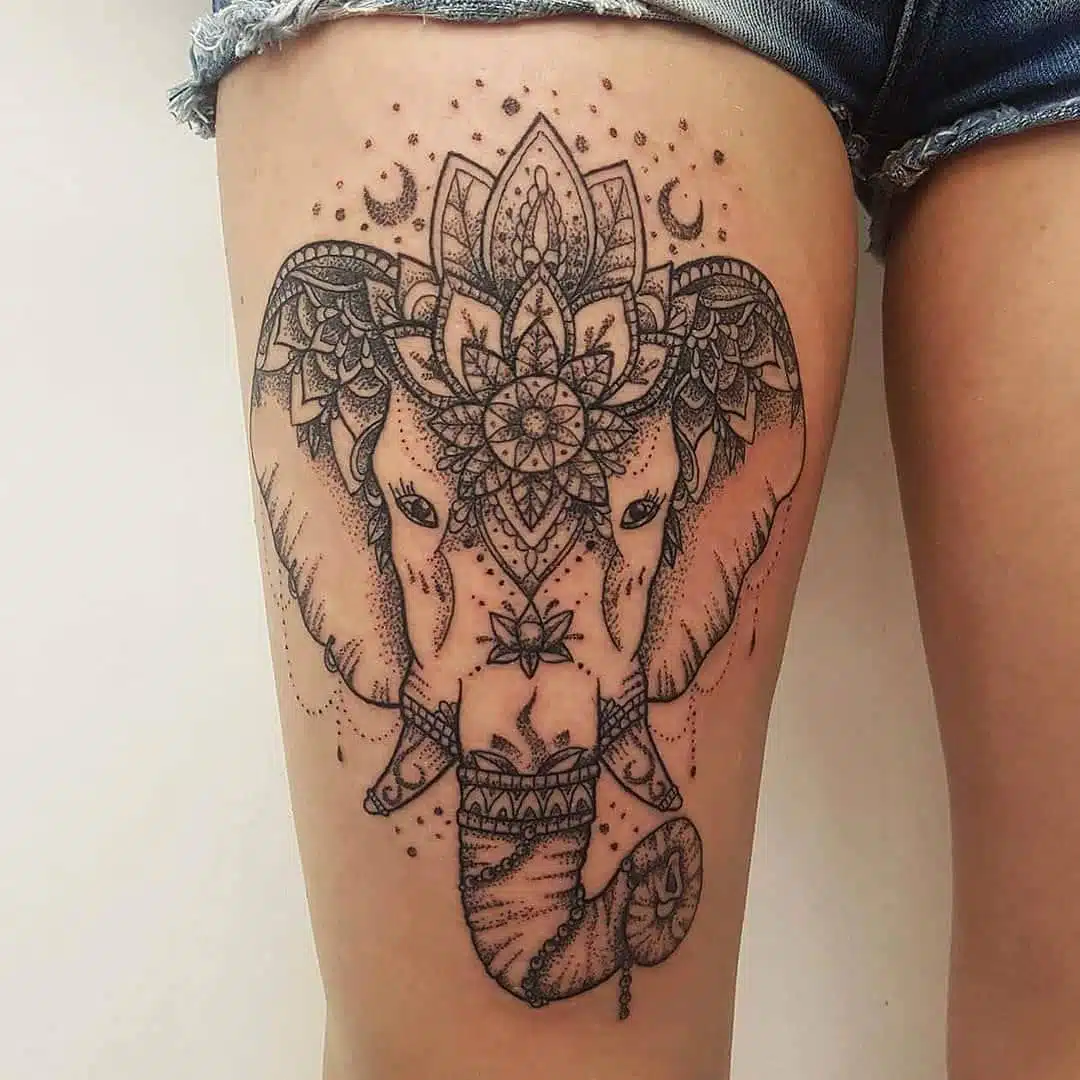Are you looking for a tattoo that not only looks beautiful but also holds spiritual and symbolic meaning? Look no further than mandala tattoos. These intricate and mesmerizing designs have been used for centuries in various cultures and spiritual traditions, and are now gaining popularity as a popular tattoo choice. In this article, we will explore the beauty and symbolism behind mandala tattoos, and how they can unleash your inner peace. So, whether you are seeking spiritual growth or simply love the aesthetic appeal of mandala designs, read on to discover the perfect mandala tattoo for you.
Are you only interested in tattoo designs and want to skip the educational part?
No problem, we got you covered! Click HERE to get inspired.
What does the mandala symbolize?
The mandala is a symbol that has deep cultural and spiritual significance in various traditions, including Hinduism, Buddhism, and Native American spirituality. The word "mandala" comes from the Sanskrit language, and it means "circle" or "center."
In general, the mandala symbolizes wholeness, balance, harmony, and unity. It represents the universe, both external and internal, and can be seen as a cosmic diagram that illustrates the relationship between the self and the world. The circular shape of the mandala represents the cyclical nature of life, death, and rebirth.
Mandalas can be used for meditation and spiritual practices, as they are believed to have a calming and centering effect on the mind. Mandalas can also be used for healing purposes, as they are believed to promote physical, emotional, and spiritual well-being.
The specific meanings of mandalas can vary depending on their designs, colors, and cultural contexts. For example, Tibetan mandalas often feature intricate geometric patterns and are used in meditation and prayer. Native American mandalas often feature natural elements and animals and are used in rituals and ceremonies.
What is the meaning behind mandala tattoos?
Mandala tattoos have become popular in recent years, and like all mandalas, they can have different meanings depending on their design, color, and cultural context. In general, mandala tattoos are often chosen for their aesthetic appeal and symbolic significance.
One common meaning of mandala tattoos is their representation of balance and harmony. As circular designs, mandalas can signify wholeness, unity, and interconnectedness. They can serve as a reminder to live a balanced and centered life.
Mandala tattoos can also symbolize spiritual growth and transformation. In some spiritual traditions, the mandala is used as a tool for meditation and self-discovery. A mandala tattoo may serve as a reminder to the wearer to continue on their spiritual journey.
The colors used in mandala tattoos can also carry symbolic meaning. For example, blue can represent calmness and stability, while purple can represent spirituality and transformation.
It's important to note that mandalas have cultural and spiritual significance to certain communities and should be approached with respect and understanding. If you are considering a mandala tattoo, it's a good idea to do research and seek out a tattoo artist who has experience in creating authentic and culturally respectful designs.
best mandala tattoo ideas and their meanings
There are countless mandala tattoo ideas, each with their own unique design and symbolic meaning. Here are some of the most popular mandala tattoo ideas and their meanings:
Lotus Mandala Tattoo
The Lotus Mandala Tattoo combines the symbolic meanings of the lotus flower and the mandala, creating a design that represents spiritual growth and enlightenment. It represents the journey towards spiritual purity and enlightenment, and the interconnectedness of all things in life. The design symbolizes balance and harmony, reminding the wearer to stay grounded while striving for spiritual growth.
Traditional Tibetan Mandala Tattoo
This intricate design often features geometric patterns and symbols, and is used in Tibetan Buddhism for meditation and spiritual practices. The Tibetan mandala can represent the universe, balance, and harmony.
Sun and Moon Mandala tattoo
This design incorporates the sun and moon, which can represent the balance between light and dark, and the cyclical nature of life.
Geometric Mandala tattoo
This modern take on the traditional mandala features geometric shapes and lines, representing balance, symmetry, and order.
Animal Mandala Tattoo
This design incorporates an animal, such as an elephant or wolf, with a mandala pattern. The animal can represent strength and power, while the mandala represents balance and harmony.
Who should get a mandala tattoo?
Anyone can get a mandala tattoo if they are drawn to the design and the symbolic meanings behind it. However, mandala tattoos are particularly popular among those who are interested in spiritual practices, meditation, and self-discovery.
If you are considering a mandala tattoo, it's important to take some time to research the meaning and symbolism behind the design. You may also want to consider working with a tattoo artist who has experience creating mandala tattoos and who can help you create a design that is authentic and meaningful to you.
It's important to remember that mandalas have cultural and spiritual significance to certain communities and should be approached with respect and understanding. If you are not familiar with the cultural or spiritual context behind the mandala design you are considering, it's a good idea to do some research and learn more before getting the tattoo.
Ultimately, a mandala tattoo can be a beautiful and meaningful way to express your personal beliefs and values, and to remind yourself to live a balanced and centered life.
History and origin of the mandala
The mandala is a sacred symbol that has been used for centuries in various cultures and spiritual traditions. The word "mandala" comes from the Sanskrit language, and it means "circle" or "center."
The exact origin of the mandala is not known, but it is believed to have originated in India, where it was used as a tool for meditation and spiritual practices. Mandalas were also used in Hindu and Buddhist art and architecture, as well as in Native American and Celtic cultures.
In Hinduism, mandalas were used to represent the universe and the relationship between the individual and the cosmos. They were often used in religious rituals and ceremonies, and were believed to have healing and transformative powers.
In Buddhism, mandalas were used as visual aids for meditation and were believed to represent the path to enlightenment. They often featured intricate geometric patterns and symbols, and were used in Tibetan Buddhist practices as well as other Buddhist traditions.
In Native American and Celtic cultures, mandalas were used in art and craftwork, often featuring natural elements such as animals, plants, and the four elements of nature.
Overall, the mandala is a symbol that has been used for centuries in various cultures and spiritual traditions, and is still used today in meditation, healing practices, and art. The circular shape of the mandala represents the cyclical nature of life, death, and rebirth, and the intricate patterns and symbols within the design represent the interconnectedness of all things.
General Breakdown Of Tattoo Pain Levels On Different Body Parts
Here is a breakdown of the different tattoo pain levels:
- Low: This level of pain is generally described as a mild discomfort or tickling sensation. It is similar to the sensation of getting a light scratch or scrape.
- Moderate: This level of pain is generally described as a moderate discomfort or aching sensation. It is similar to the sensation of getting a deep scratch or scrape or being pinched.
- High: This level of pain is generally described as a strong discomfort or throbbing sensation. It is similar to the sensation of getting a burn or being stung by a bee.
It's important to note that pain tolerance is highly individual and can vary greatly from person to person. Some people may find certain body parts more or less painful than others, and the same body part can be more or less painful for different people. Additionally, the level of pain can be affected by factors such as the size and location of the tattoo, the skill of the tattoo artist, and the individual's own pain threshold.
Tattoo placement pain level chart
Body Part | Pain Level | Explanation |
Forehead | Low | The forehead has few nerve endings, so it is not a particularly painful area. |
Eyebrows | Low | The eyebrows have few nerve endings, so the pain level is relatively low. |
Ear | Low | The ear is a relatively thin and fleshy area, so the pain level is low. |
Nostril | Low | The nostril is a small area with thin skin, so the pain level is low. |
Lip | Low to Moderate | The lip has more nerve endings than some other areas, so it may be slightly more painful. |
Cheek | Low to Moderate | The cheek has a moderate amount of nerve endings, so it may be slightly more painful. |
Moderate | The neck has a moderate amount of nerve endings, so it may be slightly more painful. | |
Moderate to High | The chest has a high concentration of nerve endings, so it can be quite painful. | |
Abdomen | High | The abdomen has a high concentration of nerve endings, so it can be quite painful. |
Back | High | The back has a high concentration of nerve endings, so it can be quite painful. |
Shoulders | High | The shoulders have a high concentration of nerve endings, so they can be quite painful. |
Upper Arms | Moderate to High | The upper arms have a moderate to high concentration of nerve endings, so they can be somewhat painful. |
Elbows | High | The elbows have a high concentration of nerve endings, so they can be quite painful. |
Forearms | Moderate | The forearms have a moderate concentration of nerve endings, so they are not as painful as some other areas. |
Hands | High | The hands have a high concentration of nerve endings, so they can be quite painful. |
Lower Arms | Low to Moderate | The lower arms have a lower concentration of nerve endings, so they are not as painful as some other areas. |
Wrists | Low | The wrists have a low concentration of nerve endings, so they are not very painful. |
Lower Back | High | The lower back has a high concentration of nerve endings, so it can be quite painful. |
Buttocks | High | The buttocks have a high concentration of nerve endings, so they can be quite painful. |
Thighs | High | The thighs have a high concentration of nerve endings, so they can be quite painful. |
Knees | High | The knees have a high concentration of nerve endings, so they can be quite painful. |
Calves | Low to Moderate | The calves have a low to moderate concentration of nerve endings, so they are not as painful as some other areas. |
Ankles | Low | The ankles have a low concentration of nerve endings, so they are not very painful. |
Tattoo aftercare tips
Before getting a tattoo:
Choose a reputable tattoo artist and parlor. Research the artist's portfolio and read reviews from previous clients.
Consult with the artist about the design and placement of the tattoo.
Make sure you are in good health. If you have any medical conditions or are taking any medications that may affect your ability to heal, be sure to let your tattoo artist know.
Consider using a numbing cream to reduce pain during the tattooing process. These creams contain a numbing agent (such as lidocaine) that can be applied to the skin before the tattoo is done. It's important to follow the instructions on the numbing cream and to only use it as directed.
Avoid alcohol, caffeine, and other substances that can thin your blood for at least 24 hours before getting a tattoo.
Eat a healthy meal before your tattoo session to ensure that your blood sugar is stable.
Wear loose, comfortable clothing that allows easy access to the area being tattooed.
After getting a tattoo:
Follow the aftercare instructions provided by your tattoo artist. These may include:
Keeping the tattoo clean and covered with a bandage for the first few hours after getting tattooed.
Washing the tattoo with lukewarm water and a mild soap (such as unscented, antimicrobial soap) and patting it dry with a clean towel.
Applying a thin layer of tattoo ointment or lotion (such as A&D or Aquaphor) to the tattoo and covering it with a clean bandage or wrap.
Repeating this process for the first few days, or until the tattoo has fully scabbed over.
Avoid soaking the tattoo in water for the first week, such as in a bath or pool.
Avoid picking or scratching at the scabs, as this can cause the tattoo to fade or become infected.
Avoid exposure to direct sunlight or tanning beds for at least 2-4 weeks.
If you experience any redness, swelling, or unusual discharge, contact your tattoo artist or a healthcare professional.
Overall, it's important to keep your tattoo clean and moisturized during the healing process to ensure that it heals properly and looks its best. Using a numbing cream can help reduce pain during the tattooing process, but it's important to use it as directed and to follow all aftercare instructions to ensure that your tattoo heals properly.
People Also Ask:
What is a mandala tattoo?
A mandala tattoo is an intricate design inspired by the Hindu and Buddhist mandalas that symbolizes balance, harmony, and the interconnectedness of all things.
What does a mandala tattoo symbolize?
A mandala tattoo symbolizes the wearer's connection to the universe, spiritual journey, and quest for balance and harmony.
What are some popular mandala tattoo ideas?
Some popular mandala tattoo ideas include the Lotus Mandala, Celtic Mandala, Sun Mandala, Moon Mandala, and Om Mandala.
Who should get a mandala tattoo?
Mandala tattoos are suitable for anyone looking for a meaningful and beautiful tattoo that symbolizes their connection to the universe, their spiritual journey, and their spiritual beliefs. They are popular among those interested in Hindu or Buddhist spirituality but are also appreciated by those who love intricate designs.
How long does a mandala tattoo take to complete?
The time it takes to complete a mandala tattoo depends on its size and complexity. A small mandala tattoo can take several hours to complete, while a large and intricate design may take several sessions to conduct.
Watch A Time-lapse video of a mandala tattoo done by a pro
150+ mandala tattoo Ideas to get inspired from
Final thoughts
In conclusion, mandala tattoos are a beautiful and meaningful form of body art that symbolizes the wearer's connection to the universe and their spiritual journey. Whether you are looking for a small and discreet tattoo or a giant and bold statement piece, a mandala tattoo is perfect for you. Suppose you are considering getting a mandala tattoo. In that case, it is essential to take the time to find a design that represents your personal beliefs and values and to choose a reputable and experienced tattoo artist to bring your vision to life.

